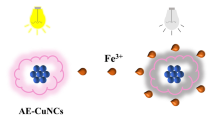Abstract
Presence of Sudan I in food stuff can be problematic and need to be checked in order to protect our health from possible carcinogen. Therefore, it is essential to detect Sudan I by efficient, rapid and reliable method. In this work, we have designed a Ru(II) polypyridyl complex, [Ru(bpy)2(CIP)]2+ probe for the selective and sensitive detection of Sudan I. Upon addition of Sudan I to the solution of [Ru(bpy)2(CIP)]2+ in ethanol, the luminescence quenched rapidly, and linear concentration range with analyte has been obtained from 0.8 to 100 μM with the limit of detection as low as 0.26 μM (S/N = 3). The effective luminescence quenching was resulted due to the inner filter effect (IFE) between luminophore, [Ru(bpy)2(CIP)]2+ and quencher, Sudan I. Our spectroscopic study was essentially provided sufficient analytical evidences in order to prove occurrence of IFE mechanism. As there were no interferences observed in luminescence measurement from the other substances the present probe has been successfully applied for the detection of Sudan I in commercial chili powder sample, making the probe suitable for practical usage.









Similar content being viewed by others
References
Towns AD (1999) Developments in azo disperse dyes derived from heterocyclic diazo components. Dyes Pigments 42(1):3–28
Vera DN, Ruisánchez I, Callao MP (2018) Establishing time stability for multivariate qualitative methods. Case study: Sudan I and IV adulteration in food spices. Food Control 92:341–347
Pei L, Ou Y, Yu W, Fan Y, Huang Y, Lai K (2015) Au-Ag Core-Shell Nanospheres for surface-enhanced Raman scattering detection of Sudan I and Sudan II in chili powder. J Nanomater 2015:1–8
Fonovich TM (2012) Sudan dyes: are they dangerous for human health. Drug Chem Toxicol 36(3):343–352
Chung K-T (2016) Azo dyes and human health: a review. Journal of Environmental Science and Health, Part C 34(4):233–261
Stiborova M, Martınek VC, Rydlova H, Hodek P, Frei E (2002) Sudan I is a potential carcinogen for humans: evidence for its metabolic activation and Detoxication by human recombinant cytochrome P450 1A1 and liver Microsomes. Cancer Res 62:5678–5684
Schwack W, Pellissier E, Morlock G (2018) Analysis of unauthorized Sudan dyes in food by high-performance thin-layer chromatography. Anal Bioanal Chem 410(22):5641–5651
Commission decision of 23 May 2005 on emergency measures regarding chilli products, curcuma and palm oil, Official Journal of the European Union (2005/402/EC) L135/34
Rebane R, Leito I, Yurchenko S, Herodes K (2010) A review of analytical techniques for determination of Sudan I–IV dyes in food matrixes. J Chromatogr A 1217(17):2747–2757
Yamjala K, Nainar MS, Ramisetti NR (2016) Methods for the analysis of azo dyes employed in food industry – a review. Food Chem 192:813–824
Dar MM, Idrees W, Masoodi F(2012) Detection of Sudan dyes in red Chilli powder by thin layer chromatography, Sci Rep 2(586)
Chailapakul O, Wonsawat W, Siangproh W, Grudpan K, Zhao Y, Zhu Z (2008) Analysis of Sudan I, Sudan II, sudan III, and Sudan IV in food by HPLC with electrochemical detection: comparison of glassy carbon electrode with carbon nanotube-ionic liquid gel modified electrode. Food Chem 109(4):876–882
Puoci F, Garreffa C, Iemma F, Muzzalupo R, Spizzirri UG, Picci N (2005) Molecularly imprinted solid phase extraction for detection of Sudan I in food matrices. Food Chem 93(2):349–353
Di Anibal CV, Marsal LF, Callao MP, Ruisánchez I (2012) Surface enhanced Raman spectroscopy (SERS) and multivariate analysis as a screening tool for detecting Sudan I dye in culinary spices. Spectrochim Acta A Mol Biomol Spectrosc 87:135–141
López-Montes AM, Dupont A-L, Desmazières B, Lavédrine B (2013) Identification of synthetic dyes in early colour photographs using capillary electrophoresis and electrospray ionisation–mass spectrometry. Talanta 114:217–226
Liu Y, Song Z, Dong F, Zhang L (2007) Flow injection Chemiluminescence determination of Sudan I in hot Chilli sauce. J Agric Food Chem 55:614–617
Wei Q-H, Han L-J, Jiang Y, Lin X-X, Duan Y-N, Chen G-N (2012) Electrochemiluminescence properties of [Pt2Ag4(C≡CC6H4R)8]n (R = CH3, n = 1; R = H, n = 1 and 2) with amine (TPrA and DBAE) as the Coreactant and determination of Sudan I. Inorg Chem 51(20):11117–11125
Zhang J, Wang M-l, Shentu C, Wang W-c, He Y, Chen Z-d (2012) Electrochemical detection of Sudan I by using an expanded graphite paste electrode. J Electroanal Chem 685:47–52
Prabakaran E, Pandian K (2015) Amperometric detection of Sudan I in red chili powder samples using Ag nanoparticles decorated graphene oxide modified glassy carbon electrode. Food Chem 166:198–205
Chang XC, Xiu Zhi HU, Yan Qin LI, Shang YJ, Liu YZ, Feng G, Wang JP (2011) Multi-determination of Para red and Sudan dyes in egg by a broad specific antibody based enzyme linked immunosorbent assay. Food Control 22(11):0–1775
Fang A, Long Q, Wu Q, Li H, Zhang Y, Yao S (2016) Upconversion nanosensor for sensitive fluorescence detection of Sudan I–IV based on inner filter effect. Talanta 148:129–134
Liu J, Zhou Z, Wang L, Xu M (2017) Using a 1,8-diamino naphthalene–copper (II) system as a turn-on fluorescence probe for detecting Sudan I. Spectrosc Lett 50(8):411–416
Zhou M, Chen X, Xu Y, Qu J, Jiao L, Zhang H, Chen H, Chen X (2013) Sensitive determination of Sudan dyes in foodstuffs by Mn–ZnS quantum dots. Dyes Pigments 99(1):120–126
Anmei S, Qingmei Z, Yuye C, Yilin W (2018) Preparation of carbon quantum dots from cigarette filters and its application for fluorescence detection of Sudan I. Anal Chim Acta 1023:115–120
Chen S, Yu YL, Wang JH (2018) Inner filter effect-based fluorescent sensing systems: a review. Anal Chim Acta 999: 13–26
Fan H, Xiang GQ, Wang Y, Zhang H, Ning K, Duan J, He L, Jiang X, Zhao W (2018) Manganese-doped carbon quantum dots-based fluorescent probe for selective and sensitive sensing of 2, 4, 6-trinitrophenol via an inner filtering effect. Spectrochim Acta A Mol Biomol Spectrosc 205:221–226
Wu M, Sun L, Miao K, Wu Y, Fan L-J (2018) Detection of Sudan dyes based on inner-filter effect with reusable conjugated polymer fibrous membranes. ACS Appl Mater Interfaces 10(9):8287–8295
Yang S, Wang C, Liu C, Wang Y, Xiao Y, Li J, Li Y, Yang R (2014) Fluorescence modulation by absorbent on solid surface: an improved approach for designing fluorescent sensor. Anal Chem 86(15):7931–7938
Zhang W, Liu H, Zhang F, Wang YL, Song B, Zhang R, Yuan J (2018) Development of a ruthenium(II) complex-based luminescence probe for detection of hydrogen sulfite in food samples, Microchem J 141:181–187
Sheth S, Li M, Song Q (2019) New luminescent probe for the selective detection of dopamine based on in situ prepared Ru(II) complex-sodium dodecyl benzyl sulfonate assembly. J Photochem Photobiol A Chem 371:128–135
Yang Z, Huang C, Wang C, Zhao Y, Song Q (2017) Novel Long-lifetime iridium complex as lab-on-a-molecule for Hg2+ and pH-Activatable probes. ACS Sustain Chem Eng 5(5):4443–4448
Yang Z, Zhao Y, Wang C, Song Q, Pang Q (2017) A water-soluble and highly phosphorescent cyclometallated iridium complex with versatile sensing capability. Talanta 166:169–175
Huang C, Ran G, Zhao Y, Wang C, Song Q (2018) Synthesis and application of a water-soluble phosphorescent iridium complex as turn-on sensing material for human serum albumin. Dalton Trans 47(7):2330–2336
Huang C, Sheth S, Li M, Ran G, Song Q (2018) Rapid and selective luminescent sensing of allergenic gluten by highly phosphorescent switch-on probe. Talanta 190:292–297
Chen L, Wang X, Zhao H, Wang K, Jin L (2008) Flow-injection chemiluminescence determination of ofloxacin using the Ru(bpy)2(CIP)2+−Ce(IV) system and its application. Luminescence 23(5):309–315
Bai G-Y, Dong B, Lü Y-Y, Wang K-Z, Jin L-P, Gao L-H (2004) A comparative study of the interaction of two structurally analogue ruthenium(II) complexes with DNA. J Inorg Biochem 98(12):2011–2015
Steck EA, Day AR (1942) Reactions of Phenanthraquinone and Retenequinone with aldehydes and ammonium acetate in acetic acid solution. J Am Chem Soc 65:452–456
Williams ATR, Winfield SA, Miller JN (1983) Relative fluorescence quantum yields using a computer-controlled luminescence spectrometer. Analyst 108(1290):1067–1071
Brouwer AM (2011) Standards for photoluminescence quantum yield measurements in solution. Pure Appl Chem 83(12):2213–2228
Pellegrin Y, Forster R, J, Keyes Tia E (2009) pH Dependent photophysics and role of medium on photoinduced electron transfer between ruthenium polypyridyl complex and anthraquinone, Inorg Chim Acta 362(6):1715–1722
Sheth S (2013) Synthesis and characterization of catalysts for photo-oxidation of water, doctoral dissertation, Université Paris Sud - Paris XI, Orsay, France
Lakowicz JR (1999) Principles of fluorescence spectroscopy. Kluwer Academic/Plenum Press, New York
Shrivastava A, Gupta V (2011) Methods for the determination of limit of detection and limit of quantitation of the analytical methods. Chronicles of Young Scientists 2(1):21
Jhonsi MA, Kathiravan A, Paramaguru G, Manivannan C, Renganathan R (2010) Fluorescence quenching of Tris(2,2-bipyridine)ruthenium(II) dichloride by certain organic dyes. J Solution Chem 39:1520–1530
Sheth S, Baron A, Herrero C, Vauzeilles B, Aukauloo A, Leibl W (2013) Light-induced tryptophan radical generation in a click modular assembly of a sensitiser-tryptophan residue. Photochem Photobiol Sci 12(6):1074–1078
Vera DM, Argiiello GA, Argiiello G, Gsponer HE (1993) The effect of pH on the luminescence quenching of tris(2,2’-bipyridine) ruthenium (II) by phenolic compounds. J Photochem Photobiol A: Chemistry 76:13–19
Yang C, Xiu W, Liu H, Ge S, Mei Y, Yu J, Song X (2017) An inner filter effect fluorescent sensor based on g-C3N4 nanosheets/chromogenic probe for simple detection of glutathione. Sens Actuators B Chem 248:639–645
Tang DD, Zhang JY, Hou XD, Peng WU (2017) Phosphorescent inner filter effect-based sensing system for determination of β -glucuronidase using manganese-doped zinc sulfide quantum dots. Chin J Anal Chem 45(12):1909–1914
Wang Y, Xiong L, Geng F, Zhang F, Xu M (2011) Design of a dual-signaling sensing system for fluorescent ratiometric detection of Al3+ ion based on the inner-filter effect. Analyst 136(22):4809–4814
Zhao Y, Zou S, Huo D, Hou C, Yang M, Li J, Bian M (2018) Simple and sensitive fluorescence sensor for methotrexate detection based on the inner filter effect of N. S co-doped carbon quantum dots, Anal Chim Acta 1047:179–187
Li Y, Wang A, Bai Y, Wang S (2017) Acriflavine-immobilized eggshell membrane as a new solid-state biosensor for Sudan I–IV detection based on fluorescence resonance energy transfer. Food Chem 237:966–973
Jose AR, Sivasankaran U, Menon S, Kumar KG (2016) A silicon nanoparticle based turn off fluorescent sensor for Sudan I. Anal Methods 8(28):5701–5706
Acknowledgements
S.S. gratefully acknowledges research grant from Jiangnan University. The authors would like to acknowledge financial support for this research work from the Fundamental Research Funds for the Central Universities (JUSRP51507), and the 111 Project (B13025).
Author information
Authors and Affiliations
Corresponding author
Ethics declarations
Conflict of Interest
There are no conflicts to declare.
Additional information
Publisher’s Note
Springer Nature remains neutral with regard to jurisdictional claims in published maps and institutional affiliations.
Electronic supplementary material
ESM 1
(DOCX 613 kb)
Rights and permissions
About this article
Cite this article
Sheth, S., Li, M. & Song, Q. Luminescent Chemosensor Based on Ru(II) Bipyridine Complex for Detection of Sudan I through Inner Filter Effect. J Fluoresc 30, 1543–1551 (2020). https://doi.org/10.1007/s10895-020-02602-2
Received:
Accepted:
Published:
Issue Date:
DOI: https://doi.org/10.1007/s10895-020-02602-2




